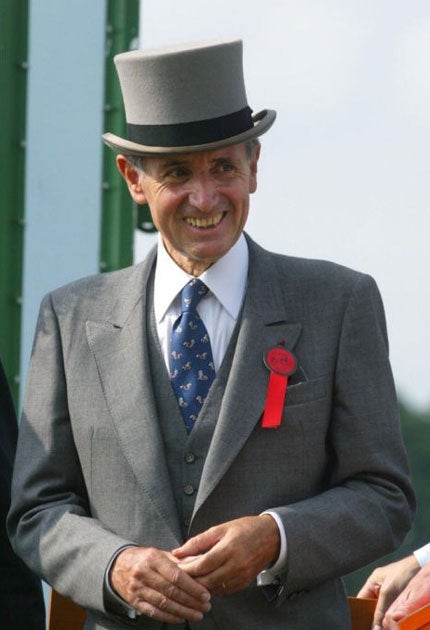Jean-Louis Dumas: Businessman who transformed Hermes into one of the world's leading luxury brands

Your support helps us to tell the story
From reproductive rights to climate change to Big Tech, The Independent is on the ground when the story is developing. Whether it's investigating the financials of Elon Musk's pro-Trump PAC or producing our latest documentary, 'The A Word', which shines a light on the American women fighting for reproductive rights, we know how important it is to parse out the facts from the messaging.
At such a critical moment in US history, we need reporters on the ground. Your donation allows us to keep sending journalists to speak to both sides of the story.
The Independent is trusted by Americans across the entire political spectrum. And unlike many other quality news outlets, we choose not to lock Americans out of our reporting and analysis with paywalls. We believe quality journalism should be available to everyone, paid for by those who can afford it.
Your support makes all the difference.Jean-Louis Dumas, the former president of Hermès, was credited with turning a niche, conservative and stagnating fashion house into one of the world's most successful luxury brands. He achieved this through sweeping changes and the audacious signing of new talent, coupled with an inventive and curious mind.
Jean-Louis Robert Frédéric Dumas was born in Paris in 1938. His father, Robert, had married one of the four daughters of Émile-Maurice Hermès, a grandson of the business's founder, Thierry; the family was originally German Protestant. Hermès was founded in 1837 as a harness and saddle maker to the French and European upper classes and royalty. However, by the 1920s, with the ascent of the automobile and a request from the Prince of Wales, the business diversified into travel and sport-related leather goods. Over the decades designs came and went, but their biggest sellers were the signature square scarves, the "Kelly" bag, named in the 1950s after Princess Grace (née Kelly) of Monaco, who was often photographed with the accessory, and the "Constance" purse, a favourite of Jacqueline Kennedy Onassis.
After attending the Institut d'Études Politiques de Paris, Dumas travelled to Scandinavia and Czechoslovakia in a jazz ensemble and then in a Citroë*CV to India and Nepal before his compulsory military service in Algeria. Throughout his life he was an intrepid traveller, using his experiences to enrich Hermès' creativity. Under his management the house famously recreated Kelly bags in rubber supplied by an Amazonian tribe.
After his marriage to Rena Gregoriadès in 1962, Dumas entered the buyer-training scheme at Bloomingdale's department store in New York. He joined Hermès in 1964 and in 1978 took over the leadership from his father, who had run the company for 27 years. Dumas set about changing the fortunes of a stagnating company. He brought in new, talented designers like Eric Bergere and Bernard Sanz to revamp the clothing division, and to introduce new luxury lines, including python motorcycle jackets and ostrich-skin jeans, in order to shed the company's equestrian image and attract a younger clientele.
Véronique Nichanian, previously with the Italian couturier Nino Cerruti, took over men's ready-to-wear in 1988, and in 1997 the Belgian iconoclast Martin Margiela was brought in to design women's wear. With his departure in 2003, the even more outrageous Jean-Paul Gaultier succeeded him amid raised eyebrows, but the gamble paid off with increased sales.
A chance encounter with the English actress and singer Jane Birkin became one of Hermès' biggest successes. Seated next to her on a Paris-to-London flight in 1984, Dumas began asking her about her tattered straw handbag and then invited her to work with Hermès to develop a new handbag design. The result was the iconic Birkin "envelope"-style bag with its distinctive locking clasp, often made of crocodile, alligator or ostrich, which became a "must-have" item, even for the most modest version at $7,500.
Dumas also embarked on a series of strategic acquisitions, buying up many of its high-quality suppliers and acquiring strategic stakes in French glassware, silverware and tableware manufacturers. Hermès later took control of Gaultier's fashion house and created alliances with other luxury firms, investing in Leica (of which he was a huge fan) and buying the name rights to the London shoemaker John Lobb.
Using his global contacts, Dumas aggressively opened new Hermès stores abroad while closing other franchises. After overseeing the diversification, Dumas launched Hermès on the Paris Stock Exchange in 1993, raising $23m in a flotation 34 times oversubscribed. Nearly three-quarters of its shares remain in family hands. In a little over three decades at the helm, Dumas transformed Hermès' annual sales of $50m to a 2009 turnover of $2.5bn.
Dumas retired in 2006 due to ill health and was succeeded by Patrick Thomas, the first non-family member to run the company in five generations. He continued his life-long passion for photography and in 2008, Steidl published a collection of his photographs, Jean-Louis Dumas: Photographer.
Jean-Louis Dumas, businessman: born Paris 2 February 1938; married 1962 Rena Gregoriadès (died 2009; one daughter, one son); died Paris 1 May 2010.
Join our commenting forum
Join thought-provoking conversations, follow other Independent readers and see their replies
Comments